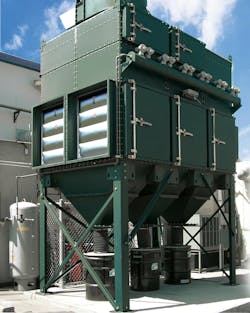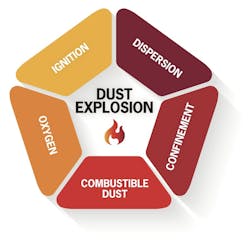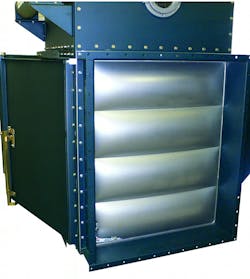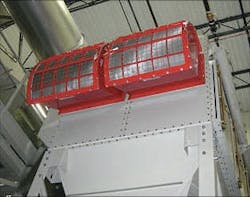Myth versus fact: Understanding combustible dust and dust collectors
Key Highlights
- Combustible dust explosions can occur in confined spaces, with secondary explosions causing extensive damage and injuries.
- Many airborne dust particles are microscopic and invisible, requiring industrial dust collectors for effective containment.
- Proper maintenance and safety systems, including explosion vents and suppression devices, are vital for preventing and mitigating dust explosions.
- NFPA standards, such as NFPA 68 and NFPA 69, provide detailed guidelines for vent sizing, explosion prevention, and safety system design.
- Testing of dust for combustibility and conducting Dust Hazard Analyses are essential steps in managing explosion risks.

If your facility handles materials or powders that generate dust during processes such as handling, transferring, packaging, or processing, you may face the risk of a combustible dust explosion. These explosions occur when a dense cloud of combustible dust ignites in a confined space.
The initial event, known as a primary explosion, typically occurs in an isolated area. However, the resulting pressure wave can dislodge settled dust throughout the facility, triggering additional, more destructive secondary explosions that propagate rapidly and cause significant damage.
Combustible dust incident statistics
Recognizing which materials are most often involved in dust explosions and fires is critical to ensuring workplace safety.
According to DustEx Research Ltd., between January 1, 2023, and January 1, 2024, there were 263 fires, 53 explosions, 94 injuries and 62 fatalities worldwide related to combustible dust incidents.
Of these global incidents, food and wood products accounted for 79% of the fires and explosions, 76% of the injuries, and 24% of the fatalities. Notably, dust collectors were involved in 13% of all combustible dust fires and explosions during 2023.
U.S. loss data from 2016 through 2023 show an average of 28 dust explosions per year, resulting in 25 injuries annually and 1 – 6 fatalities per year. Dust fires are excluded from this analysis.
Separating combustible dust myths from facts
Understanding the realities of dust control and explosion risk is essential for maintaining a safe and compliant facility. The following Myth vs. Fact section clarifies several common misconceptions and provides accurate insights for effectively managing hazardous dust.
Myth: Hazardous dust is easy to see and identify.
Fact: Many airborne dust particles present in industrial environments are too small to be seen with the naked eye. Industrial dust collectors are designed to capture and contain these microscopic particles by cycling the dust-laden airstream through filter cartridges that trap the contaminants and return clean air to the workspace. Dust collectors are typically large-scale systems located either indoors or outdoors, depending on safety requirements and regulatory compliance.
Myth: Explosions in dust collectors are rare and random, so there is no need to worry about them.
Fact: Explosions can occur in any dust collector when a concentrated cloud of combustible dust is suspended within the system. A single spark or ember from production processes, static discharge or other ignition sources can ignite the dust cloud and trigger an explosion.
Proper maintenance and safety measures are critical to minimizing this risk. Active explosion protection devices are designed to detect and respond to ignition events in real time, suppressing explosions before they can fully develop. Passive systems, by contrast, activate after an explosion begins, venting or isolating the event to protect personnel and equipment.
Myth: Dust collector explosions can always be prevented.
Fact: While it is not always possible to prevent an explosion, systems can be designed to ensure that such events do not cause harm. Explosion protection systems, including explosion vents, isolation valves, and safety monitoring filters, are critical for mitigating incidents. These technologies, guided by National Fire Protection Association (NFPA) standards, are designed to safely contain an explosion within the dust collector rather than allowing it to propagate into the facility.
The NFPA 660: Standard for Combustible Dusts that went into effect on December 6, 2024, consolidates six existing NFPA standards into one comprehensive guideline. This standard simplifies compliance by combining general principles and industry-specific requirements to help facilities manage combustible dust risks and enhance fire and explosion safety.
Myth: Explosion vents are unnecessary if collectors are built robustly.
Fact: Explosion vents are vital safety features and remain the most common method of protecting industrial dust collectors. When dust inside a collector combusts, internal pressure rises rapidly. Properly designed explosion vents open at a predetermined pressure, allowing the pressure and flame front to exit safely. This venting protects personnel and minimizes structural damage. NFPA 68: Standard on Explosion Protection by Deflagration Venting outlines the criteria for the design, placement, installation and maintenance of these systems.
Myth: Only certain facilities need to test their dust for combustibility.
Fact: According to NFPA 660, testing is required whenever a dust is suspected to be combustible. It is standard practice to assume a process dust is explosive unless testing confirms a Kst (deflagration index) value of zero.
If testing indicates combustibility, NFPA 660 requires that the facility perform a Dust Hazard Analysis (DHA) to determine both the Kst and the Pmax (maximum pressure rise). Any dust with a Kst value greater than zero is considered explosive, and most industrial dusts fall within this category. These include food products such as flour, sugar and spices that do not seem innately dangerous. The finer the particles, the higher the explosion potential.
A DHA identifies potential combustion and explosion hazards and determines the appropriate fire and explosion protection measures. Dust collection system manufacturers also require accurate Kst and Pmax data to properly design and size explosion venting or suppression systems, which is the only way to ensure both safety and compliance.
Myth: Vent and discharge duct sizing is straightforward and does not require specialized calculations.
Fact: Explosion venting is a highly specialized process that must be engineered to safely release combustion gases and pressure from a dust collection system or other enclosure. Correct vent sizing and ducting are crucial to minimize structural and mechanical damage.
NFPA 68 specifies detailed formulas for calculating proper vent and discharge duct sizes. Meanwhile, NFPA 69: Standard on Explosion Prevention Systems provides broader guidance covering entire dust collection systems, including inlet and outlet ducting, spark suppression, and measures to prevent flame propagation back into the building or upstream processes.
Myth: Dust collectors should always be installed outdoors.
Fact: Although outdoor installation is generally safer, it is not always mandatory. The NFPA recommends locating dust collectors where they can vent to a safe, unoccupied area. Outdoor systems must vent away from buildings and personnel zones.
For indoor installations handling combustible dust, appropriate explosion protection systems must be integrated. Flameless venting devices allow pressure relief indoors without releasing external flames, though they are not recommended for toxic dust applications due to possible particulate release. When selecting a flameless venting solution, insist on third-party-certified testing data from the manufacturer.
Additional protection options include explosion isolation valves, which prevent flame and pressure from traveling through ductwork, and integrated safety monitoring filters, which isolate downstream equipment during an explosion event.
Any indoor dust collector handling combustible dust must have an NFPA-compliant explosion protection system.
About the Author
Brian Richardson
Brian Richardson is the Northwest Regional Sales Manager for Camfil Air Pollution Control, a manufacturer of dust and fume collection equipment for challenging industrial applications.


